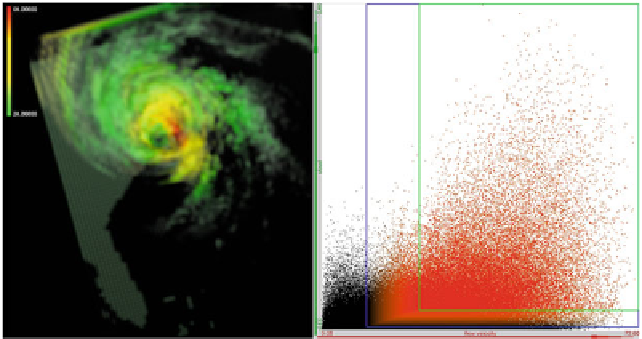Image Processing Reference
In-Depth Information
Fig. 15.2
Brushing-and-linking
correlates multiple views by making it possible to select a data
subset in one view, e.g., selected ranges in attribute/field space, and consistently highlighting this
subset in all other views. Changing color (e.g., showing the selected points in a different color (
left
)
or using saturation (
right
)) is a common way to achieve this effect of highlighting the emphasized
data subset over its context (commonly referred to as focus plus context (F
+
C)
are usually called
brushing
. Highlighting in this instance serves as means of
linking
views together, and this technique is referred to as
brushing-and-linking
1
[
1
,
19
].
For example, in the hurricane case, one might be interested in spatial regions cor-
responding to fast moving clouds. Using brushing-and-linking it is possible to select
such a feature in the scatter plot [Fig.
15.2
(right)] and highlight the corresponding
regions in other views, such as in a physical view of the hurricane [Fig.
15.2
(left)].
Using brushing-and-linking, it is possible to formulate simple queries interactively,
such as “where are regions of high temperature and low velocity” and visualize the
results in a physical view. While there are many instances, where such features of
interest are known a priori and analysis is driven by known queries [
29
], the full
power of IVA lies in the fact that a user can discover features of interest during
interaction and pose or refine queries during interactive analysis.
As a consequence, IVA often defines “features” as data subsets of interest to the
user, be it due to prior knowledge or because a data subset has caught the user's
attention. Common user interactions include brushing for outliers (e.g., to determine
why a subset is behaving differently from the rest), regions of strong correlation
(e.g., to verify if this correlation holds in the entire data set or only in particular
subsets), or a spatial region of interest, like an inlet or outlet of a flow simulation
(e.g., to determine if a correlation exists in that region). In general, we distinguish
three patterns of explorative/analytical procedures:
1
We note that the visualization community uses the order “linking-and-brushing” more commonly,
while the database community uses the order “brushing-and-linking”. We use the term “brushing-
and-linking” here as brushing is usually performed before linking.

Search WWH ::

Custom Search